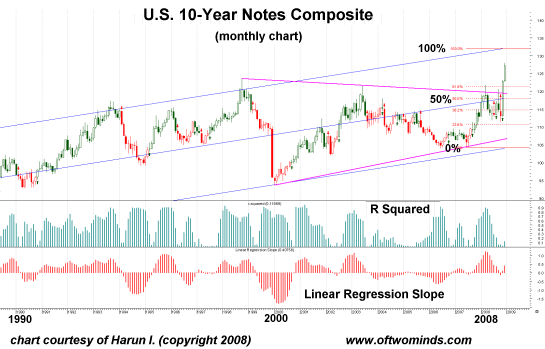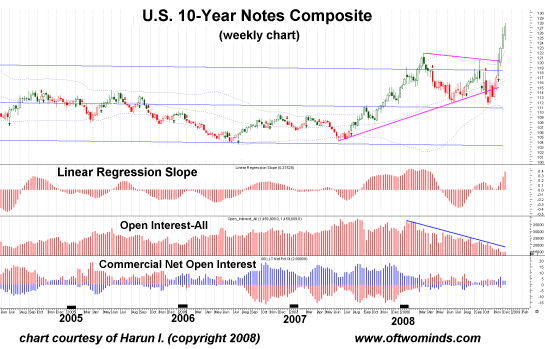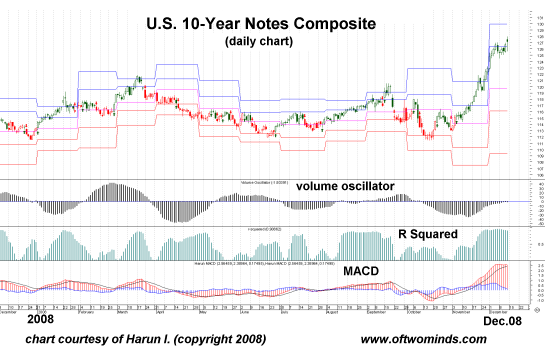(December 17, 2008)
With the Federal Reserve lowering its Fed funds rate to near-zero and speculators--
oops, I mean "investors"--fleeing commodities and stocks, bonds
have skyrocketed. Is it a new long-term trend or yet another bubble?
Super-low Fed rates and a flight to safety (i.e. the market is still expecting the
U.S. Treasury to repay its bonds and interest due) have pushed U.S. bonds to the
stratosphere. Recall that bonds' yield and face value act as a teeter-totter; a
drop in yields raises the face value, and a rise in yield pushes down face value.
I asked frequent contributor Harun I. for some charts and commentary on the
10-year bond. While these charts look to me very much like a round, fragile object
floating a few feet above the ground--i.e. a bubble--as Harun takes pain to note,
we have to respect any breakout.
As always, please read the HUGE GIANT BIG FAT DISCLAIMER below which states that
nothing here should be mistaken for investment advice; this is a free site and you
get what you pay for, (heh) i.e. my observations and opinions. Harun's opinions are his
own and they too should not be mistaken for investment advice.
Here are Harun's notes on the charts:
By examining the three charts, one must accept without equivocation that a valid
breakout of a major multiyear formation has occurred at the primary level.
Momentum and trend indicators are just beginning to register but this is typical
in fast markets.

On the monthly chart, a push to the top of the SE channel may be at hand. The
confluence of the upper channel line and the 100% extension makes this a likely
target. But the measuring implications of the formation indicate much higher prices.
Which will prevail? We will have to wait and see.

The weekly chart with COT (Commitment of Traders) data indicates that while price
movement is explosive,
the mechanisms that are needed for sustainable price advancement are lacking. Open
interest has all but dried up. Relative to times past, Commercial and Large Traders
are noncommittal. While I did not include a Volume indicator, 25-week average volume
is hovering around 30% below 50-week average volume. In short, capital flows and
trader participation do not support price acceleration.
With that said, one must never argue with price. Traders may wake up and get on board
this rally.
US 10-year notes are outperforming gold but the disparity between nominal value
and real value is still quite significant. (No chart)

Finally, the daily chart indicates a successful assault on the R1 monthly pivot
point with the major histogram of MACD overbought and the minor histogram declining
toward equilibrium indicating a loss of short-term acceleration. Volume has
strengthened from a very weak reading to parity with average 50-day volume. Even
at the short-term level volume has not confirmed this rally.
As I have stated, it is never prudent to argue with price. If on the trend, stay
on the trend but be mindful of the quality of price movement. Large interests can
push around thin markets and clearly this market is thin.
If you have been whipsawed, donít feel bad, Jim Rogers was forced to cover his
shorts in bonds last week. If he was forced to cover I suspect many others were
as well, which helped fuel this rally.
Is this a bubble? Of course it is; by now this should not be news. The Bond/Gold
ratio is proof enough of the degree of distortion in US Treasury markets.
Is this the final blow off? I do not know, it could be. The current run-up is
undoubtedly irrational. The fundamentals in the American debt markets, private
and public, are severely impaired. The belief is that the US government will
print money until collapse rather than repudiate its debt. The fallacy of this
is evident; collapse is repudiation.
Referring back to the monthly (primary level) chart, if price stalls at the upper
channel line and falls through the lower trend line of the wedge then the
formation will have failed and a rapid descent can be expected.
On the other hand, the normal cycle is for bonds to top, then stocks, then
commodities. Conversely, bonds typically bottom first, then, stocks, then
commodities (e.g., US Treasuries topped in 1998, equities topped in 2000,
commodities topped in 2001). If this were to hold true, regardless of the why
or how impossible one may think it, at some point a rally in stocks and commodities
is inevitable.
As stated earlier, the quality of the rally in the 10-year note is dubious. Traders
in all classes are non-committal and volume on a relative basis does not confirm.
That these divergences are occurring at all levels of trend should indicate caution.
January may prove pivotal as we go into the New Year overbought. This year, price
could not close solidly below the January low, and a major rally is underway now
that the January high has been solidly penetrated.
Thank you, Harun, for the knowledgeable commentary. In a side note, I want to
note that the (Bear-Market) stock market rally that I anticipated in my December 1 entry appears
to be underway.
Thank you, readers for the many excellent comments. With holiday-related work
in full swing, I am hoping to post your comments tomorrow. Thank you for your patience.
Here is Part III of Chris Sullins' strategic action thriller,
Operation SERF:
Operation SERF, Part III
"This is an illegal assembly!" proclaimed the man wearing a slate gray uniform, black boots, olive drab web gear and carrying a submachine gun.
The uniformed man walked down the center aisle between the rows toward the altar area where a young man stood at the head of the assembled group. Two other men dressed in a similar manner with weapons stood back toward the entrance and behind the people. The faces of all three were cleanly shaved and straps from their gray helmets were snapped around their chins. When the uniformed man made it to the front he turned around to face the audience with his back toward the young man. He let his firearm dangle by its sling, took off his helmet and held it under his left arm.
Operation SERF, Part I
Operation SERF, Part II
Holiday gift announcement: maximum two signed books per customer:
Signed copies of Claire's Great Adventure
(perfect for that impossible teen on your "gotta get them something, arggh" list)
are limited to two per customer: $12 for one (includes $2.58 postage), $22 for two.
The regular price on amazon.com is $16.99; the $12 (incl. shipping/postage) is
a special offer I am making to readers. Please send $12 via check
(email me for an address)
or via my
Paypal account with instructions on how to inscribe the book, and I will mail the book(s)
directly to you. If you'd like to read
other readers' reviews before buying a copy, the cover image below links
to the amazon.com page and two readers' reviews.
Book Notes: My "little book of big ideas,"
Weblogs & New Media: Marketing in Crisis is now available on amazon.com for $10.99.
is now available on amazon.com for $10.99.
"Charles Hugh Smith's Weblogs & New Media: Marketing in Crisis is one of the most
important business analyses I have ever read. It is the first to squarely face
converging global crises from a business perspective: peak oil, climate change,
resource depletion, and the junction of key social cycles will radically alter
the business landscape in coming decades...."

"This guy is THE leading visionary on reality.
He routinely discusses things which no one else has talked about, yet,
turn out to be quite relevant months later."
--An anonymous comment about CHS posted on another blog.
NOTE: contributions are acknowledged in the order received. Your name and email
remain confidential and will not be given to any other individual, company or agency.
|
Thank you, Robert D. ($25) for your most generous donation
to this site.
I am greatly honored by your support and readership.
|
|
Thank you, Gavin G. ($100) for your mind-bogglingly generous donation
to this site.
I am greatly honored by your support and readership.
|
Or send him coins, stamps or quatloos via mail--please
request P.O. Box address.
Your readership is greatly appreciated with or without a donation.
For more on this subject and a wide array of other topics, please visit
my weblog.
All content, HTML coding, format design, design elements and images copyright ©
2008 Charles Hugh Smith, All rights
reserved in all media, unless otherwise credited or noted.
I would be honored if you linked this wEssay to your site, or printed a copy for your own use.


